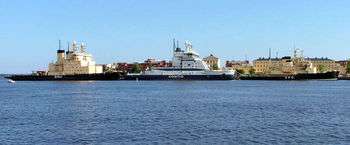Finnish maritime cluster

The Finnish maritime cluster is a cluster of companies in maritime industries in Finland. In 2001 the total turnover was estimated at 11.4 billion euros and it employed 47,000 people.
History
Small trading ships similar to Jacobstads Wapen were built in Finnish coastal towns in the 18th century. Small-scale shipyards continued to exist well into the 20th century. The first large scale shipyard was the galley dry dock at Sveaborg built in the mid-18th century, which serviced the ships that won one of the largest sea battles in Finnish history.
The first shipyard in Turku was established in 1732. After the Crimean War, William Crichton acquired a workshop and built a new shipyard, which later was merging smaller shipyards and developed into Crichton-Vulcan, merged with Wärtsilä between 1936 and 1938.
Soviet trade
A major boost to Finnish shipbuilding was the war reparations paid to the Soviet Union after World War II. They forced a rapid industrialization of Finland and the creation of a large metal industry in addition to the traditional papermaking and forest industries.[1] By 1953, the shipbuilding industry had six times the capacity it did in 1944.[2]
Bilateral trade with the Soviet Union forced Finnish shipyards to build ships with a high percentage of total value of Finnish origin. All major components of the finished products needed to be produced domestically. The high percentage of domestic components continues even after the dissolution of the Soviet Union and the end of the lucrative trade deals. While ships built in other European shipyards are a collection of components from around Europe and around the world, ships built in Finland can have up to 90% of their total value in Finnish components and labor (kotimaisuusaste).[3][4][5][6][7][8][9][10]
Major companies

- STX Finland Cruise Oy (now Meyer Werft Turku) with shipyards in Turku, Helsinki, and Rauma
- ABB, formerly Strömberg, producer of Azipod Azimuth thrusters and electrical systems
- Hollming Group, now part of Aker Finnyards; producer of Aquamaster (now Rolls-Royce) Z-drive Azimuth thrusters
- Kone Corporation
- Cargotec (Split from KONE in 2005, formerly Navire Cargo Gear and MacGregor) provides cargo-handling solutions
- Wärtsilä provides maritime diesel engines
- Sanitec, a former subsidiary of Wärtsilä, provides closed loop sanitation systems
- Steerprop, Rauma, Azimuth Propulsors[13][14]
- Deltamarin, naval architecture[15][16]
- Aker Arctic, naval architecture and ice model testing
Ships


Icebreakers
Submarines
Cruise liners
- Oasis class (2009, 220,000 tons), formerly known as Project Genesis
- Freedom class (158,000 tons)
- Voyager class (142,000 tons)
- Spirit class (85,700 tons)
- Vision class (81,500 tons)
- Fantasy class (70,390 tons)
- Royal Princess (44,348 tons, 1984)
- Song of Norway (1970)
Cruiseferries
- M/S Viking Grace (2012)
- M/S Viking XPRS (2008)
- M/S Star (2007)
- M/S Color Fantasy (2004)
- M/S Silja Symphony (1991)
- M/S Silja Serenade (1990)
- M/S Viking Cinderella (1989)
- M/S Mariella (1985)
- M/S Rosella (1980)
- GTS Finnjet (1977)
Warships
- Ilmarinen (1931), first battleship with a diesel-electric drive
- Helsinki class missile boat
- Rauma class missile boat
- Hamina class missile boat
- Tuuli class hovercraft
References
- ↑ Childs, Marquis (1961-12-11). "Tough Finns Appear Unperturbed By The Shadow In The East". St. Petersburg Times. Retrieved 10 July 2011.
- ↑ "Industrial Progress in Finland". The Windsor Daily Star. 2011. Retrieved 10 July 2011.
- ↑ Jarmo Seppälä (2011-12-21). "Pituutta 96 metriä - Raumalla rakennetaan uusi laiva Rajavartiolaitokselle". Tekniikka & Talous (in Finnish).
Laivan kotimaisuusaste on noin 90 prosenttia.
- ↑ "Rauman telakka luovutti erikoisaluksen Namibiaan". Laivagalleria (in Finnish). 2012-07-21.
kotimaisuusaste on 85-90 prosenttia
- ↑ "Jättiristeilijä Oasis of the Seas lähti kohti Karibiaa". turku.f (in Finnish). 3.12.2009.
Projektin kotimaisuusaste on korkea.
Check date values in:|date=(help) - ↑ Kerttu Vali (December 17, 2012). "Uudentyyppinen Jäänmurtaja Perämerelle". Laivat & Merihistoria (in Finnish).
Uuden satamajäänmurtajan suunnittelu, potkurilaitteistot, pääkoneet, teräsmateriaalit sekä suurin osa työstä tulevat Suomesta. Hankinnan kotimaisuusaste onkin korkea, arviolta 85 prosenttia.
- ↑ "Varsinaissuomalainen laivanrakennusteollisuus – Suomen lippulaiva" (PDF). Tekniikan Akateemiset (in Finnish) (8). 2001.
Aluksen kotimaisuusaste on 80 %
- ↑ "TS: Jättitilaus voi lipua Turun telakalta sivu suun". Taloussanomat (in Finnish). 2012-12-16.
hankkeen kotimaisuusaste on 80 prosenttia.
- ↑ "Risteilijäkauppa suuressa vaarassa" (in Finnish). Meriteollisuus ry. 2012-12-16.
Tällaisten tilausten kotimaisuusaste on peräti 80 prosenttia.
- ↑ Marko Laitala (6.2.2006). "Maailman kallein laiva rakennetaan Turussa". Tekniikka & Talous (in Finnish).
Suomessa rakennettujen laivojen kotimaisuusaste on 80–90 prosenttia.
Check date values in:|date=(help) - ↑ Jouko Veijonaho (April 9, 2010). "Rolls-Roycelle uusi aluevaltaus potkurimarkkinoilta" (PDF). Uusi Aika (in Finnish). Pori: 5.
- ↑ "ROLLS-ROYCE OY AB". Finland Exports.
- ↑ Tapio Pukkila (2012-10-10). "Steerprop sai ison tilauksen Italiaan". YLE Uutiset (in Finnish).
- ↑ "Steerprop propulsors chosen for dual fuel STQ ferry". Marine Log. October 16, 2012.
- ↑ Jabour, Bridie (19 June 2012). "Titanic II a step closer to reality". Brisbane Times.
- ↑ "Global Ship Design Firm Commissioned to Titanic II Project". Blue Star Line. 19 June 2012.
External links
- The Finnish Maritime Cluster Study
- The Finnish Maritime Cluster 2003
- Aker Yards
- Developing bigger and better cruise ships at hightechfinland.com
